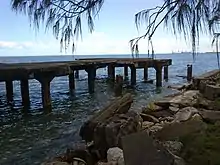Cribb Island, Queensland
Cribb Island was a suburb of Brisbane, Queensland, Australia, which is now part of the site of Brisbane Airport.[1] The suburb is perhaps best known for being the childhood home of the Gibb brothers, who later became famous as the Bee Gees.

"Cribbie", as it was known by the locals, consisted of two areas which were made up of Cribb Island and Jackson's Estate. The entire area of Cribb Island which was about 5 kilometres (3.1 mi) long and 400 metres wide was built essentially on a mud flat that faced Moreton Bay. In the 1970s, the land was resumed by the Federal Government to expand the Brisbane Airport's capability for the larger jets ('Heavies') used in international flights.
Cribb Island also gave its name to a local variety of marine worm (probably Onuphis sp. Fam. Eunicidae), popular with fishermen as bait.
History
_northeast_of_Brisbane%252C_1889.jpg.webp)
The original area of Cribb Island was populated in 1884 by a tribe of approximately 50 Indigenous Australian people, who bartered their locally-caught fish and mud crabs for bread and potatoes from the early European settlers.
Cribb Island received its name from John George Cribb (1830—1905). He was the son of Robert Cribb, an alderman of the Town of Brisbane and member of the Queensland Legislative Assembly. John George Cribb bought 150 acres (0.61 km2) of land from the Queensland Government in 1863. In 1885, Cribb sold 65 of those acres to James Jackson for the purpose of growing bananas. This area became known as Jackson's Estate. The land that wasn't used by Jackson was leased out to livestock farmers.[2]
Historically, there was only one road into Cribb Island. At first, as this road was floated on top of logs across the mud-flat, it was susceptible to flooding and brief periods of inaccessibility. In 1914 an improved road was built, allowing for access by standard motor vehicles.
Cribb Island State School opened on 18 August 1919 and closed on 14 December 1979.[3] It was located on Cribb Island Road at approximately 27.3583°S 153.1167°E with the camping reserve immediately to its south.[4]
Later on through the 1920s, the Cribb Island and Jackson's Estate areas became a tourist destination and seaside resort area due to their close proximity to Brisbane's town centre. Cribb Island Post Office opened in November 1920 and closed in 1980.[5] In 1925, Cribb Island had its first bus service which was privately owned and ferried passengers to and from the city.
Going into the 1930s the town had many essential services including a school, general store, cafés etc. The resident population fluctuated around 400.
The 1930s however saw a change in the area's fortunes as it was at the mercy of a severe economic downturn. House owners were forced to sell their houses in the Cribb Island area to make ends meet and sold them for next to nothing. The poor bought these homes and the area became a haven for those struggling to get by. Although more local business moved in to provide basic services, this demographic remained the status quo until the end of the suburb's existence.
Cribb Island was the childhood home of Bee Gees pop stars Barry, Robin and Maurice Gibb.
In 1970, the Commonwealth Government proceeded to resume land on the island for the purpose of upgrading the airport. The population at that time was about 900 people. Over the next decade, people slowly moved out of the area as the Government took control of the land. The last resident unwillingly left her home in 1980.
On 22 September 1986 the Queensland Government decided to remove the names Cribb Island and Lower Nudgee from the official maps because "no trace of either suburb remains".[6]
Many former residents are keeping memories of Cribb Island alive on various websites and writer Tracy Wills has written a book, On the Flats: The Road to Cribb Island, about childhood experiences growing up in this remote peaceful community.[7]
Today little remains of Cribb Island as the land was reclaimed and extensively redeveloped as part of Brisbane Airport, with the new runway which now appears over the former suburb being officially completed in 2020.
References
- "Cribb Island (entry 40543)". Queensland Place Names. Queensland Government. Retrieved 10 January 2015.
- "University of Queensland: Queensland Places: Cribb Island". Archived from the original on 1 March 2011. Retrieved 18 February 2011.
- Queensland Family History Society (2010), Queensland schools past and present (Version 1.01 ed.), Queensland Family History Society, ISBN 978-1-921171-26-0
- "Cadastral map of Queensland Twenty Chain (1:15840) series sheet 2546 displaying real property information; majority of road names and Administrative Areas including Parish and County". Queensland Government. 1971. Retrieved 2 January 2020.
- Premier Postal History. "Post Office List". Premier Postal Auctions. Retrieved 5 June 2012.
- "Item ID2627419, Queensland Place Names Act 1981 - Approval of Place Names. - Mr W.H. Glasson". Queensland State Archives. Retrieved 11 September 2020.
- "On the Flats - On the Road to Cribb Island". Archived from the original on 10 March 2015. Retrieved 18 February 2011.
Further reading
- "CRIBB ISLAND DISTRICT". The Brisbane Courier. Queensland, Australia. 8 September 1928. p. 13 – via Trove.
External links
| Wikimedia Commons has media related to Cribb Island, Queensland. |